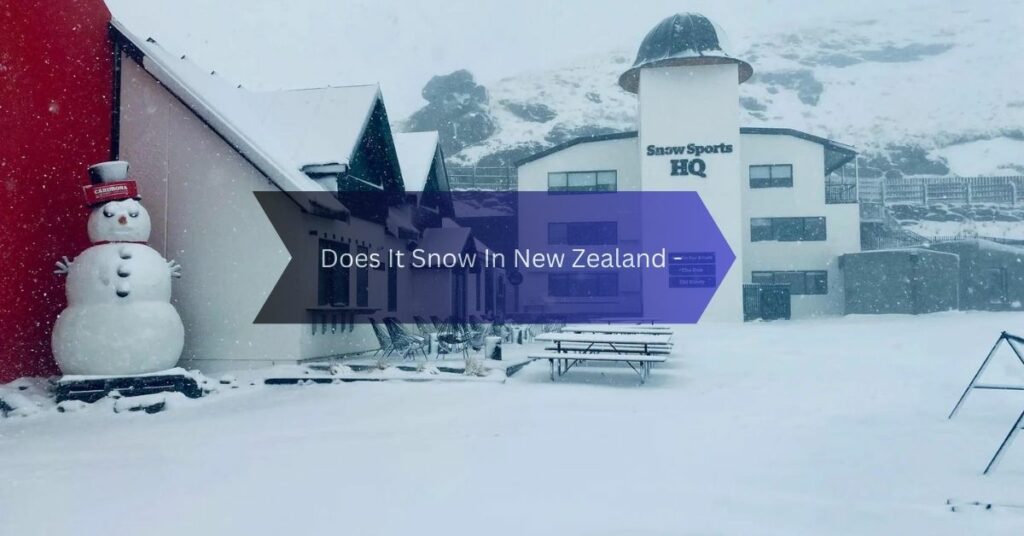New Zealand, an island nation in the southwestern Pacific Ocean, is renowned for its stunning landscapes, diverse ecosystems, and vibrant culture.
Yes, it snows in New Zealand during the winter months (June to August), primarily in the mountainous regions of the North and South Islands.
Let’s dive deeper into the snowy side of this beautiful country and uncover what makes New Zealand a winter wonderland for so many.
Geography And Climate Of New Zealand
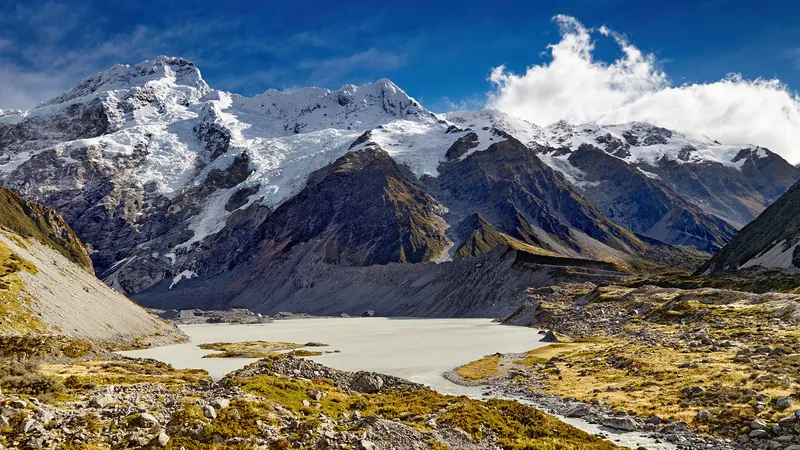
Overview Of New Zealand’s Geographical Layout
New Zealand comprises two main islands, the North Island and the South Island, and numerous smaller islands. The country’s diverse topography includes everything from rolling hills and fertile plains to dramatic fjords and towering mountain ranges.
The Southern Alps, which run along the length of the South Island, are particularly noteworthy and play a significant role in the country’s weather patterns.
Explanation Of New Zealand’s Climate Zones
New Zealand’s climate is primarily influenced by its latitude, proximity to the ocean, and varied topography. The country is divided into several climate zones:
- Subtropical Zone: Found in the northern parts of the North Island, including regions like Northland and Auckland. This zone experiences warm, humid summers and mild winters.
- Temperate Zone: Covers most of the North Island and the northern parts of the South Island, including cities like Wellington and Nelson. This zone has moderate temperatures year-round, with more rainfall in the winter months.
- Oceanic Zone: This zone predominantly affects the west coast of both islands. This area experiences high precipitation levels throughout the year, making it lush and green.
- Continental Zone: This zone is found in the interior regions of the South Island, particularly in areas like Central Otago and Canterbury. It has more extreme temperature variations, with hot summers and cold winters.
- Alpine Zone: This zone covers the high-altitude areas of the Southern Alps. It has cold temperatures year-round and significant snowfall in the winter months.
These climate zones contribute to the diverse weather patterns observed across New Zealand.
General Weather Patterns In New Zealand
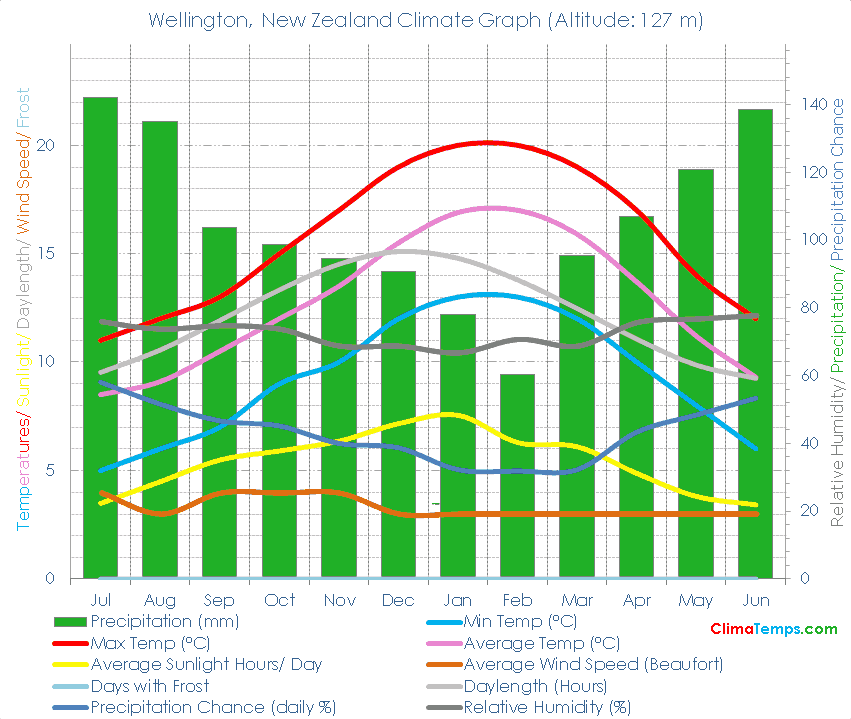
Summer Vs. Winter Temperatures
New Zealand experiences a temperate maritime climate, meaning that temperatures can vary significantly between summer and winter but are generally mild compared to many other countries.
- Summer Temperatures (December to February): During the summer months, temperatures across New Zealand range from warm to hot. In the North Island, average daytime temperatures typically hover between 20°C to 25°C (68°F to 77°F), while the South Island experiences slightly cooler conditions, averaging between 15°C to 23°C (59°F to 73°F).
- Winter Temperatures (June to August): Winter brings cooler temperatures nationwide. The North Island sees daytime temperatures ranging from 10°C to 15°C (50°F to 59°F), whereas the South Island is colder, with temperatures between 5°C to 10°C (41°F to 50°F).
Precipitation Patterns Throughout The Year
Precipitation in New Zealand is highly variable and largely influenced by the country’s topography and the prevailing westerly winds.
- North Island: The North Island generally experiences higher rainfall in the winter months, from June to August, particularly in the western regions. The east coast, including cities like Napier and Gisborne, tends to be drier due to the rain shadow effect of the central mountain ranges.
- South Island: The west coast of the South Island is one of the wettest regions in the world, receiving substantial rainfall year-round, especially in Fiordland and Westland. The east coast, including cities like Christchurch and Dunedin, is much drier, thanks to the Southern Alps’ rain shadow.
- Seasonal Variations: Spring (September to November) and autumn (March to May) are transition periods with moderate temperatures and variable weather, including occasional rainfall and cooler evenings.
Understanding these general weather patterns is crucial for planning activities and travel in New Zealand.
Snow on the North Island
Mount Ruapehu
Mount Ruapehu, located in the central part of the North Island, is the highest mountain in the region and a prominent volcano within Tongariro National Park. It is one of the most popular destinations for winter sports enthusiasts, offering extensive skiing and snowboarding opportunities. Mount Ruapehu hosts two major ski areas: Whakapapa and Turoa.
- Whakapapa Ski Area: As New Zealand’s largest ski area, Whakapapa provides a variety of slopes suitable for all skill levels, from beginners to advanced skiers. The Happy Valley beginner’s area is particularly well-regarded for newcomers to snow sports.
- Turoa Ski Area: Known for its wide, open runs and impressive vertical drop, Turoa is a favorite among more experienced skiers and snowboarders. The area also boasts some of the longest ski runs in New Zealand.
Mount Taranaki
Mount Taranaki, also known as Mount Egmont, is another key location for snow in the North Island. This symmetrical volcanic peak, located in Egmont National Park, is renowned for its striking resemblance to Mount Fuji in Japan. While it doesn’t have the extensive ski infrastructure of Mount Ruapehu, Mount Taranaki still attracts climbers and hikers who are eager to experience its snowy slopes.
Typical Snowfall Amounts
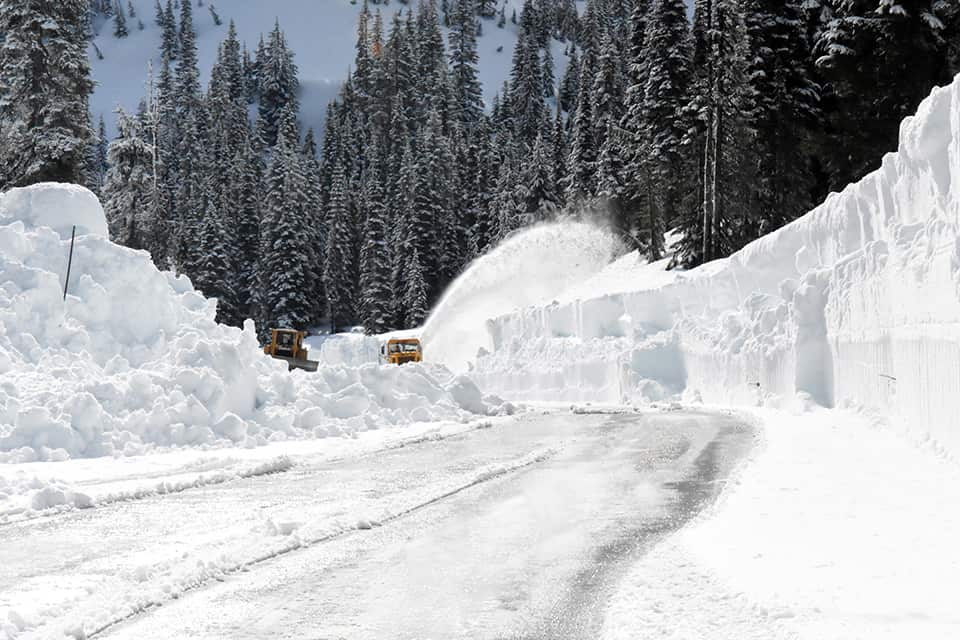
Seasonal Variations
The snowfall on the North Island’s mountains varies significantly with the seasons. Snow typically begins to fall in late autumn (May) and can last until early spring (October). The peak snow season is during the winter months, from June to August when the snowfall is most reliable and the snowpack is most resounding.
Average Snowfall Statistics
- Mount Ruapehu: On Mount Ruapehu, Whakapapa and Turoa ski areas receive an average snowfall of approximately 3 to 4 meters (10 to 13 feet) annually. The depth and quality of the snow can vary each season, with the highest elevations maintaining a consistent snow cover throughout the winter months. These ski areas also benefit from snow-making facilities, which help maintain good skiing conditions even when natural snowfall is lower.
- Mount Taranaki: Snowfall on Mount Taranaki is less predictable and generally lighter than Mount Ruapehu. The Manganui Ski Area typically sees a seasonal snow depth of around 1 to 2 meters (3 to 6 feet), but conditions vary widely yearly. Snow can often be found at higher elevations, while lower slopes may have limited coverage, especially in milder winters.
Read: Pollaste: A Comprehensive Guide
Snow In the South Island
Southern Alps
The Southern Alps are a major mountain range running the length of the South Island. They provide some of the most dramatic and snowy landscapes in New Zealand, including several prominent peaks and ski resorts.
- Aoraki/Mount Cook: The highest peak in New Zealand, Aoraki/Mount Cook, is a notable feature of the Southern Alps. While not a ski destination, it attracts climbers and hikers year-round.
Queenstown
Queenstown, nestled on the shores of Lake Wakatipu, is a world-famous destination for winter sports and adventure activities. The town is surrounded by several key ski areas, making it a hub for snow enthusiasts.
- The Remarkables: This ski field offers varied terrain suitable for all levels, with stunning views over Queenstown.
- Coronet Peak: Known for its extensive facilities and night skiing, Coronet Peak is one of the most accessible ski areas from Queenstown.
Wanaka
Wanaka, located near Lake Wanaka, is another popular winter sports destination. It offers a more laid-back atmosphere than Queenstown and has access to several renowned ski resorts.
- Cardrona Alpine Resort: Famous for its wide-open slopes and excellent snow conditions, Cardrona is ideal for families and freestyle skiers.
- Treble Cone: Known for its challenging terrain and stunning views, it is favored by more experienced skiers and snowboarders.
Typical Snowfall Amounts
Seasonal Variations
The South Island experiences significant seasonal snowfall, typically starting in late autumn (May) and lasting until early spring (October). The peak snow season runs from June to August, with the best conditions often occurring in July and August.
Average Snowfall Statistics
- Southern Alps: The Southern Alps receive substantial snowfall; some areas get up to 10 meters (33 feet) annually. The snowpack in higher elevations remains consistent throughout the winter season.
- Queenstown Ski Areas: The Remarkables and Coronet Peak generally receive around 2 to 3 meters (6 to 10 feet) of snowfall each season. These resorts also utilize snow-making technology to ensure good skiing conditions.
- Wanaka Ski Areas: Cardrona Alpine Resort and Treble Cone receive approximately 2 to 4 meters (7 to 13 feet) of snow annually, and due to its higher base altitude, Cardrona often benefits from better snow retention.
North Island Ski Resorts
Whakapapa Ski Area
Whakapapa, located on the slopes of Mount Ruapehu, is the largest ski area in New Zealand. It offers a diverse range of terrain suitable for all levels, from beginner slopes in the Happy Valley area to challenging black runs and off-piste areas for advanced skiers. The ski area also features modern facilities, including a ski school, rental shops, and various dining options.
Turoa Ski Area
Also situated on Mount Ruapehu, Turoa is known for its wide, open runs and impressive vertical drop. Turoa offers some of the longest ski runs in New Zealand and a mix of terrain that appeals to both intermediate and advanced skiers and snowboarders. The resort has high-speed chairlifts, terrain parks, and excellent snow-making capabilities to ensure a long ski season.
South Island Ski Resorts
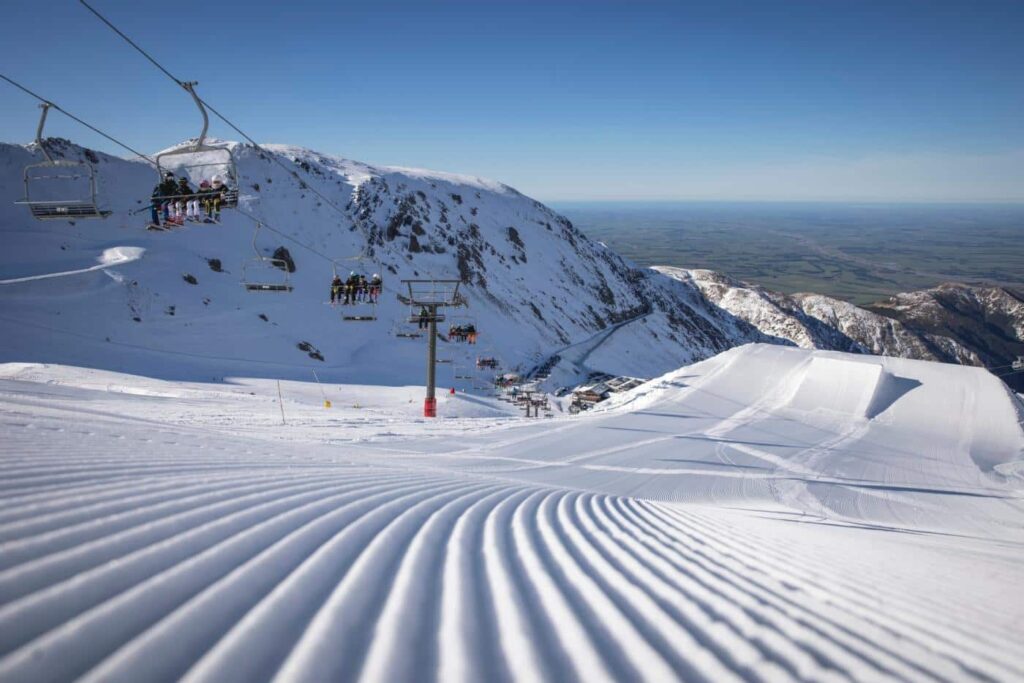
Cardrona Alpine Resort
Cardrona Alpine Resort, located near Wanaka, is famous for its family-friendly atmosphere and extensive freestyle facilities, including halfpipes and terrain parks. The resort offers a mix of beginner, intermediate, and advanced runs, making it suitable for all skill levels. Cardrona’s high base altitude often results in reliable seasonal snow conditions.
Treble Cone
Treble Cone, also near Wanaka, is renowned for its challenging terrain and stunning views of Lake Wanaka and the Southern Alps. The resort boasts the largest skiable area in the South Island and features steep slopes, natural halfpipes, and long groomed runs. Treble Cone is a favorite among advanced skiers and snowboarders looking for a thrilling experience.
The Remarkables
Located near Queenstown, The Remarkables ski area is known for its dramatic scenery and versatile terrain. The resort offers a good mix of beginner, intermediate, and advanced runs, with dedicated freestyle areas and backcountry access. The Remarkables is also popular for its friendly atmosphere and family-oriented facilities, making it a great destination for all skiers and snowboarders.
Read: Galenmetzger1 – A Visionary Entrepreneur’s Journey
Winter Activities Beyond Skiing
New Zealand’s winter wonderland offers more than just skiing and snowboarding. For those looking to diversify their winter activities, the country provides many options that allow you to explore its stunning landscapes in unique and exciting ways. Here are some popular winter activities beyond skiing:
Snowshoeing
- Mount Ruapehu: The Whakapapa and Turoa areas offer guided snowshoeing tours that take you through breathtaking alpine scenery.
- Queenstown and Wanaka: Snowshoeing trails around these areas provide stunning views of the Southern Alps and surrounding lakes.
Snowmobiling
- Queenstown: Guided snowmobile tours take you through remote backcountry areas, offering spectacular views and a sense of adventure.
- Cardrona Valley: Snowmobile safaris here provide a unique way to experience the winter landscape and are suitable for beginners and experienced riders alike.
Ice Skating
- Paradice Ice Skating Rink: Located in Auckland and Botany, these rinks offer a fun ice skating experience complete with rental skates and family-friendly sessions.
- Queenstown Ice Arena: Set in the picturesque Queenstown Gardens, this outdoor rink provides a charming setting for ice skating, surrounded by snow-capped mountains.
Scenic Winter Tours
- Milford Sound Winter Cruises: Experience the awe-inspiring fjords of Milford Sound under a blanket of snow. Winter cruises offer a peaceful way to explore this natural wonder, with fewer crowds and enhanced scenery.
- Winter Wine Tours: The Central Otago region, known for its world-class wineries, offers winter wine tours. During these tours, you can sample local wines while enjoying stunning winter vistas.
Impact of Snow on Transportation
Road Conditions During Snowfall
Snowfall can significantly affect road conditions in New Zealand, particularly in the mountainous regions and higher elevations. Due to snow and ice accumulation, roads may become slippery and hazardous, leading to slower travel times and an increased risk of accidents. Key mountain passes, such as the Lindis Pass and the Crown Range Road, are often subject to closures or restrictions during heavy snowfalls to ensure safety.
Tips for Driving in Snowy Conditions
- Prepare Your Vehicle: Ensure your vehicle is equipped with snow chains and that you know how to fit them. Check that your tires are suitable for winter conditions and that your vehicle is in good working order.
- Drive Slowly and Cautiously: Reduce your speed and increase the following distance to allow more time to react to slippery conditions. Avoid sudden braking and sharp turns.
- Stay Informed: Monitor weather forecasts and road condition updates before and during your journey. New Zealand Transport Agency (NZTA) provides regular updates on road conditions.
- Emergency Kit: Carry an emergency kit with essentials such as warm clothing, blankets, food, water, a flashlight, and a first aid kit in case you get stranded.
Impact on Air Travel
Snowfall can also impact air travel in New Zealand, particularly at airports near mountainous regions. Heavy snow can lead to flight delays, cancellations, and airport closures.
- Check Flight Status: Before heading to the airport, check the status of your flight for any delays or cancellations.
- Arrive Early: Give yourself extra time to reach the airport, especially if traveling by road during snowy conditions.
- Stay Updated: Contact your airline for the latest information and be prepared for possible changes to your travel plans.
Frequently Asked Questions:
1. Does It Snow In New Zealand Year-Round?
No, snow in New Zealand typically falls during the winter months, from June to August, with some regions experiencing snowfall as early as May and as late as October. Snowfall is primarily confined to the mountainous areas and higher elevations of the North and South Islands.
2. What Is The Coldest Month In New Zealand?
The coldest month in New Zealand is usually July. During this time, temperatures are at their lowest, especially in the South Island and mountainous areas where frost and snow are common.
3. Are There Any Safety Concerns For Tourists In Snowy Regions?
Yes, tourists should be aware of potential hazards such as slippery roads, avalanches in alpine areas, and rapidly changing weather conditions. When venturing into snowy regions, it is important to follow local advice, carry appropriate gear, and be prepared for emergencies.
4. Can You See Snow In New Zealand Without Skiing?
Absolutely! There are many ways to enjoy the snow in New Zealand without skiing. Activities such as snowshoeing, snowmobiling, ice skating, and scenic winter tours offer excellent alternatives for experiencing snowy landscapes.
5. How Do I Get To The Best Snow Destinations In New Zealand?
Most major snow destinations are accessible by road. For example, you can reach Mount Ruapehu by car from cities like Auckland and Wellington.
In the South Island, Queenstown and Wanaka are popular gateways to nearby ski resorts and can be reached by flights from major New Zealand cities or by scenic drives.
Conclusion
New Zealand’s diverse climate and stunning landscapes make it a unique destination for experiencing snow. From the volcanic peaks of the North Island to the majestic Southern Alps of the South Island, the country offers a variety of snowy adventures for travelers and locals alike.
Whether you’re hitting the slopes at world-class ski resorts like Whakapapa and Cardrona, exploring serene winter activities such as snowshoeing and ice skating, or navigating snowy roads to reach your destination, New Zealand’s winter wonderland has something for everyone.
Read:
